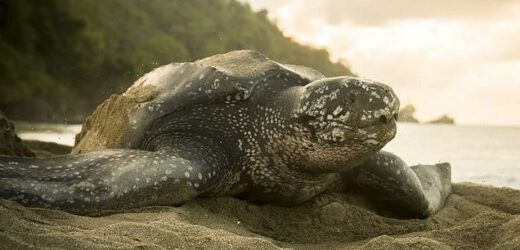Not so exotic after all! Giant turtles usually found in South America and Africa are now so common in UK waters that they ‘should be classed as British animals’, experts say
- Visits from leatherback and loggerhead turtles are becoming more common
- Charity Froglife says 15 leatherbacks are spotted in UK waters each year
- They are calling for marine turtles to be recognised as typical British animals
Giant turtles may seem exotic, but they visit our seas regularly enough to be considered ‘normal’ British animals, according to a conservation charity.
Usually associated with beaches in South America and Africa, visits from leatherback and loggerhead turtles are common enough to suggest that the seas around Britain are a home from home.
Despite weighing up to 1 ton and reaching 7ft in length, on average, 15 leatherback turtles, the most common type, are spotted in UK waters each year.
But the true number of visitors to British seas is likely to be much higher, as turtles can swim quite deep and can keep a low profile.
Reptile and amphibian charity Froglife has called for marine turtles to be recognised as typical British animals.
Usually associated with beaches in South America and Africa, visits from leatherback (pictured) and loggerhead turtles are common enough to suggest that the seas around Britain are a home from home
Professor Roger Downie, a Froglife trustee, wrote that the figure of 15 leatherbacks a year ‘is bound to be a vast underestimate of the turtle numbers actually present in British waters’. The vast majority of visiting turtles, around 84 per cent, are leatherbacks, but 12 per cent are loggerheads, and 3 per cent Kemp’s ridley turtles.
He added that they are ‘incredibly difficult to locate as they rarely emerge from the depths to breathe, nor to do they nest on British beaches; so the chances of actually spotting one in the huge expanses of our coastal waters are slim.’
A 5ft turtle, thought to be a leatherback, was spotted off the coast of Wales in August 2020 by a fisherman who said he had never seen one in 20 years of fishing.
Professor Downie said that the fisherman ‘was certainly lucky’ to spot one.
But he added: ‘Although they may seem like an exotic species, these data clearly show that we should regard leatherback turtles as normal members of the migratory fauna that inhabits our surrounding seas.’
Professor Matthew Whitt, a turtle specialist at Exeter University, said that big turtles are drawn to UK waters by jellyfish.
The vast majority of visiting turtles, around 84 per cent, are leatherbacks, but 12 per cent are loggerheads, and 3 per cent Kemp’s ridley turtles
‘You would not think that turtles are standard animals, like robins or dolphins, animals we might take for granted,’ he said.
‘Most people would only interact with turtles on TV, seeing pictures of sandy beaches and turtles laying an egg. We should see them as part of our natural fauna, they aren’t waifs or vagrants. Certainly leatherback turtles are frequent summer residents of our seas.
‘They come here to eat because our waters are so attractive with lots of jellyfish, so they have plenty of food.’
The bigger turtles can travel to the UK because their larger body mass makes them more resistant to the colder waters off our coasts, he said.
Records show most turtles are seen on the western side of the UK, including the English Channel, all around Ireland and north to the Orkneys and Shetlands. Leatherbacks and loggerheads have been recorded at all times of the year, with peaks between June and October for leatherbacks and November to March for loggerheads. Kemp’s ridleys have only been seen from October to February.
Dr Peter Richardson, head of ocean recovery at the Marine Conservation Society, said: ‘Six of the world’s seven marine turtle species have been recorded in UK waters, with leatherback turtles visiting our waters every summer to feed on jellyfish blooms.
‘The other species usually strand either dead or dying on our shores in the winter and are almost always young turtles that have strayed into the UK’s chilly seas. If they’re still alive they can be rescued, so long as they’re reported and not put back in the sea.
‘A suite of legislation in the UK already protects marine turtles, for example, all seven species are included on Schedule 5 of the Wildlife and Countryside Act, so they are already considered to be part of the UK’s amazing diversity of marine wildlife.
‘Taking part in the Marine Conservation Society’s turtle sightings programme is a fantastic way to help us better understand turtles in UK waters – but you will be lucky if you spot one, they are few and far between – and last year there were just 14 reports of turtles in UK waters.’
WHAT ARE LEATHERBACK TURTLES AND WHAT DO WE KNOW ABOUT THEM?
Leatherback turtles are named for their shell, which is leather-like rather than hard, like other turtles.
They are the largest sea turtle species and also one of the most migratory, crossing both the Atlantic and Pacific Oceans.
Leatherbacks weigh between 600 and 1,500 lbs (270 to 700 kg) on average and are normally between 55 to 63 inches (140 to 160 cm) in length.
Leatherback turtles (pictured) are named for their shell, which is leather-like rather than hard, like other turtles. They are the largest sea turtle species and also one of the most migratory, crossing both the Atlantic and Pacific Oceans (stock)
Pacific leatherbacks migrate from nesting beaches in the Coral Triangle all the way to the California coast to feed on the abundant jellyfish every summer and fall.
Although their distribution is wide, numbers of leatherback turtles have seriously declined during the last century as a result of intense egg collection and fisheries bycatch.
Globally, leatherback status according to the International Union for Conservation of Nature, leatherbacks are listed as Vulnerable
Many subpopulations – such as in the Pacific and Southwest Atlantic – are Critically Endangered.
Source: Read Full Article





